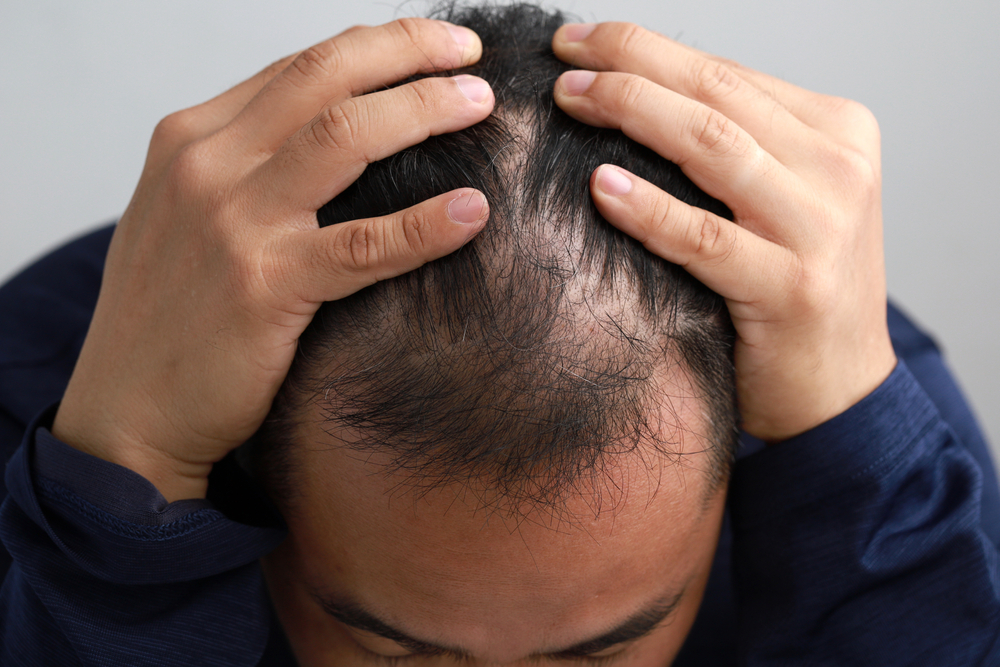- Home
- Psychogenic alopecia (psychological baldness)
alopecia
Psychogenic alopecia (psychological baldness)
Scientific collaboration between Professor Marco Toscani and Dr. Pasquale Fino, Chair of Plastic, Reconstructive and Aesthetic Surgery, Umberto I Health Center – “Sapienza” University of Rome.

Psychogenic alopecia is a type of hair loss related to stress. Though not yet scientifically explained, this connection is well-known in the experience of those working with the problem. In addition to stress, other causes are personality disorders, states of anxiety and depression, all of which are conditions of acute or chronic stress.
The mechanism of action is nevertheless related to a “somatization” process or rather to a physical reflection of psychological stress; this makes the condition different than traction alopecia (hair loss from pulling), which is also related to a psychological disorder but of the behavioural type (it is a mechanical action that leads to the condition of hair loss).
Before defining the hair loss as psychogenic, spot baldness and pattern hair loss need to be excluded. This is not a simple diagnosis and the conditions may even overlap. More than one study has implicated the hypothalamus and the pituitary gland in the biological reaction to stress, which leads to the release of adrenocorticotropic hormones in the circulation that affect cells involved in hair formation and nourishment: cells producing sebum, keratinocytes, fibroblasts and immune cells. This reaction leads to: hypersecretion of sebum that often turns into seborrheic dermatitis; trichodynia (sensation of scalp pain), especially around the crown; perifollicular inflammation (reddened skin around the hair region).
All of these symptoms may also occur in the other two types of hair loss mentioned above.
Unlike spot baldness, which generally proceeds in patches, female stress-related hair loss leads to a scattered thinning of hair, more marked in the crown area, without recession of the hairline. In men, in addition to general thinning, the condition also leads to a receding hairline.
Obviously the best cure is removal of the stress, but this is particularly difficult, especially in individuals suffering from psychogenic hair loss who are definitely people that tend to have difficulty releasing their tension. It may prove hard to remove the cause for the stress and even psychotherapeutic approaches may take a lot of time without ever guaranteeing complete removal of the stress.
Treatment definitely requires consistency and perseverance. The therapy includes: minoxidil, finasteride and laser therapy, which do not remove the cause but are a valuable aid in countering the effects of the stress.
Hair and Scalp
READ ALL ARTICLESHair Loss
READ ALL ARTICLESHair Problems
READ ALL ARTICLESScalp Problems
READ ALL ARTICLESAlopecia
READ ALL ARTICLESPreventions and Solutions
READ ALL ARTICLESHair loss solutions for you. CRLAB, specialists in the well-being of your hair and scalp.
FIND YOUR NEAREST CENTER
Let our experts find the best solution for you.
FIND YOUR NEAREST CRLAB CENTERBOOK A CONSULTATION
Book a consultation with our experts. Find out more about CRLAB solutions.
MAKE AN APPOINTMENTTrichology scalp and hair care
To put the health back into your hair, you first need to nourish your scalp. Our trichology treatments care for your scalp and hair, using cutting-edge technologies with a full range of laboratory-tested products. All made with high quality raw materials.
Find out moreHair prosthetic system
The ultimate answer to your hair loss. Rediscover yourself, with naturally thick hair. A patented solution that integrates real hair into areas where you’re experiencing thinning or hair loss. A fully customized hair enhancement that will look totally natural on you. Plus, it’s so functional, it gives you the freedom to live your life the way you want to.
Find out moreHair transplant surgery
Hair transplantation is recommended for those who wish to improve hair density and coverage. The degree of thinning may vary and must be assessed in relation to the donor area.
Find out more

 Italiano
Italiano  Português
Português  Français
Français  Español
Español 




